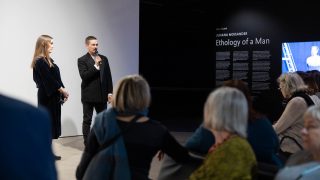Espoo Museum of Modern Art
Artist interview with Juhana Moisander


EMMA's Curator Laura Kokkonen interviewed artist Juhana Moisander, whose artwork premieres at EMMA. His new work Ethology of a Man examines models of human group behaviour that repeat themselves from one historical era to another. The video installation has been created in cooperation with a contact improvisation group. It depicts dynamics of power and the rise and fall of leaders.
Laura Kokkonen: You often depict the inner struggles of humans, a condensed state of emotions, or the moment of an ethical choice. Your previous works have usually included one or two characters. Now your Ethology of a Man features nearly 20 performers.
Juhana Moisander: I have often dealt with the topic of temptation – how an individual is drawn either to good or evil in their choices. This new work started to come to life when I was considering how the environment and group pressure affect an individual’s moral choices.
Your work is visually based on old paintings. How did you select your reference point in 16th and 17th century Baroque paintings?
I have always enjoyed the relation of light and shadow in Caravaggio’s paintings. I took that as a visual reference in this work when I was thinking how groups of people have been depicted in art history in an “orthodox” manner: where does the tension lie, and what makes a group into something visually interesting. I examined altarpieces and groups of people in them and not so much the themes that the paintings are based on. The relationship between individuals in these paintings is always one where the group gathers around a central figure, a king or Jesus. I started to think about how to create such an imagery in a space. I am always interested in how an artwork connects with the surrounding architecture and how an interaction with the spectator is formed. I used some references from art history, yet, although there are recognisable elements in the imagery, my aim was that it does not call to mind a specific work or art.
You consider in your work, the dynamics of a mass of people and the role of an individual in this group.
I am no social psychologist, but I am interested in the deindividuation of a person in a group context. The situation where the values of the surrounding society or group start to subtly impact one’s own values and where, finally, the individual merges into the group.
What sort of groups do you mean and how do they function?
People are brought together by, for instance, a church, a demonstration or a concert. These groups are always temporary by nature – they convene and then disintegrate. The group of people condenses and an individual becomes part of something larger than themself. The situation reaches a point of culmination after which everyone slowly breaks apart and retreats to their nook. In order to function, the group needs a focus point through which the common message or reason of existence can be channeled.
Through the process of deindividuation, the individual is capable of greater feats, for instance sacrificing oneself for another – the group supplies the momentum to do this. I have mostly, however, considered the dark side of deindividuation: the moment where an individual’s responsibility for their own actions flames out. The surrounding environment defines the norm and can silence the individual’s own moral and ethical voice. This enables atrocities, for instance, the Holocaust, which regular people participated in.
What is the significance of the message that brings people together?
We are manipulated by content, but in the end it is not so relevant. It is more a question of suggestion and the creation of visions when a specific political slogan, image or symbol is repeated over and over again. This creates neural networks that can suddenly activate a large group of people simultaneously. Be it the marketing of a certain product or for instance a political agenda where a negative image is created of another person or group of people.
You have referred to the concept of a ‘soul of crowds’. What does this mean?
When crowd psychology became a subject of study in the 19th century, God became less significant and attention shifted towards mankind and, for instance, the question of how the mind functions. How does human instinct work and what underpins it, and what are its consequences? Obviously crowds have been psychologically managed also earlier in history. The concept of a soul of crowds was introduced by French sociologist Gustave Le Bon (1841-1931) who described crowd psychology in his book The Crowd: A Study of the Popular Mind, although from a racist perspective. As far as I know, this was the first scholarly overview that attempted to deconstruct the group behaviour of people. Both Hitler and Mussolini had read Le Bon’s theories on the management of groups and on how people behave during wartime. Le Bon referred to Napoleon as a prime example of a leader. A leader needs to believe in their own message in order to excite the masses. Once the image of the leader has gained momentum, there is not much difference as to what kinds of lies the leader introduces, and people start to act like sheep. If someone else breaks away, others will follow. The individual merges into the group and the leader and the group have more force than the will of the individual. In later times, for instance Sigmund Freud studied Le Bon and found much to correct in his thoughts. The same was done by Elias Canetti in his book Crowds and Power.
So, a group needs a unifying message and the figure of a leader in order to take shape. When does a group fall apart?
A group falls apart when its energy evaporates – when a leader has been stripped of power, a war is over, the condensation has reached its zenith, and the cohesive reasoning is no longer there. There is no more fuel and slowly everything fades away. The music ends and the church bells start to ring.
The impact of media on group behaviour is very different today than what it used to be. Artificial intelligence and the use of mass data bring a whole new dimension to crowd psychology.
The methods of influencing perceptions have always been there but now they are very specific and widespread. All marketing can be tailored and targeted when there is enough data mass produced and calculated by artificial intelligence. Humans are at in their essence biological beings, animals that can be influenced using specific measures and whose perceptions can be directed. Even if we use computers and smart technology, we are still defined as people by the neural networks in our brains which function in a certain way. The genetic imprint of humans is so old that what has been shaped through evolution will not be erased in a passing moment. I also think that these behavioural models are universal to humankind, even if there are cultural differences depending on whether someone lives, for instance, in an urban community or in the countryside.
Nowadays we encounter an astonishing number of stimuli, perceptions are adopted intuitively and concentration skills have weakened. Human reactions have, in a certain way, shifted in a primitive direction. The world of advertisement has long been studying how to manipulate behaviour. Now, for example, the troll factories of the Trump campaign have implemented this type of manipulation on a larger and more dangerous scale. Good education and media literacy do play a role, but the machinery of a media that closely observes us as individuals still offers quite scary scenarios. The capital provided by understanding mass psychology has previously been of the mental kind; now mass data on people is concrete merchandise. At the same time, the number of extremist movements has grown and there is a visible longing for authoritarian governments.
The terrors of the Second World War and totalitarianism are starting to seem distant.
The direct imprint on our memory is starting to fade.We no longer have personal experiences of war. Humans are starting to seem quite weak-willed from this perspective. We all have the human trait of ambivalence in us – I suppose the core question is whether to follow the masses or to make one’s own decisions and follow one’s own conscious. And we have to ask at which point personal morality starts to break down and one starts to commit horrible deeds without feeling a sense of personal responsibility for them anymore.
On the other hand, group pressure also enables good deeds: if everyone decided to plant trees… It depends on the message that is being portrayed.
The artwork Ethology of a Man has been realised through co-production funding by The Promotion Centre for Audiovisual Culture (AVEK) and EMMA.
Read more and watch a video on how the artwork was made.


